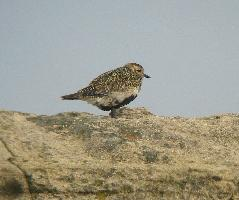
Animal description
The European Golden Plover, scientifically known as Pluvialis apricaria, is a captivating bird species that belongs to the Charadriidae family, which is known for its diverse group of ground-nesting birds. This species is particularly notable for its striking plumage, intriguing migratory patterns, and the unique ecological role it plays across its habitat range.Adult European Golden Plovers possess a distinctive appearance, especially during the breeding season. They display a beautiful, spangled golden and black pattern on their back and wings, which serves as an effective camouflage against predators when nesting on the ground. The underparts are black in breeding males, creating a sharp contrast, while females and non-breeding males have a more muted coloration, with the black replaced by a buff or whitish belly speckled with gold. Their faces and breasts are marked with black, creating a bold pattern against the lighter background of their plumage. Juveniles and non-breeding adults are less distinctly marked, with more uniform brownish or grayish tones providing camouflage in their different habitats.
Standing at about 26-29 cm in length, with a wingspan ranging from 67-76 cm, the European Golden Plover is a medium-sized bird. Its bill is relatively short and dark, while its legs range in color from dark gray to black. The species exhibits a round head and a slender, yet sturdy body, adapted for its long migratory flights.
One of the most fascinating aspects of the European Golden Plover is its migratory behavior. Breeding primarily in the tundra and moorlands of northern Europe and Asia, these birds undertake a long journey to wintering grounds in southern Europe and North Africa. During migration, they are known for their incredible endurance and have been recorded flying up to 4,000 kilometers non-stop across the ocean, a testament to their remarkable navigation and stamina.
The European Golden Plover prefers open landscapes such as tundra, heathlands, and agricultural fields for breeding. Their nests are simple scrapes on the ground, lined with vegetation, where the female lays a clutch of typically four eggs. Both parents participate in incubating the eggs and caring for the chicks, which are precocial and leave the nest shortly after hatching to find food.
Diet-wise, the European Golden Plover feeds on a variety of invertebrates, including insects, worms, and mollusks, which they pick from the ground with their sharp bills. Their feeding behavior is characterized by a distinctive run-and-stop pattern, where they sprint across the ground before pausing to look and listen for prey.
Conservation status of the European Golden Plover varies across its range, but generally, the species is considered to be of least concern, thanks to stable population numbers. However, habitat loss and changes in agricultural practices pose ongoing threats to their breeding grounds, making conservation efforts important to ensure their continued survival.
In summary, the European Golden Plover is a species that captivates with its beauty, astonishes with its migratory feats, and plays a vital role in the ecosystems it inhabits. Its presence is a reminder of the interconnectedness of our world's habitats and the importance of preserving them for future generations.
Similar Animals
New photos of animals
Top 10 animals
- Dolphin gull (Leucophaeus scoresbii)
- Diana monkey (Cercopithecus diana)
- Moustached guenon (Cercopithecus cephus)
- Galápagos tortoise (Geochelone nigra complex)
- Russian tortoise (Testudo horsfieldii)
- Japanese macaque (Macaca fuscata)
- Stone loach (Barbatula barbatula)
- Greek tortoise (Testudo graeca)
- Common flying dragon (Draco volans)
- Colossal squid (Mesonychoteuthis hamiltoni)


